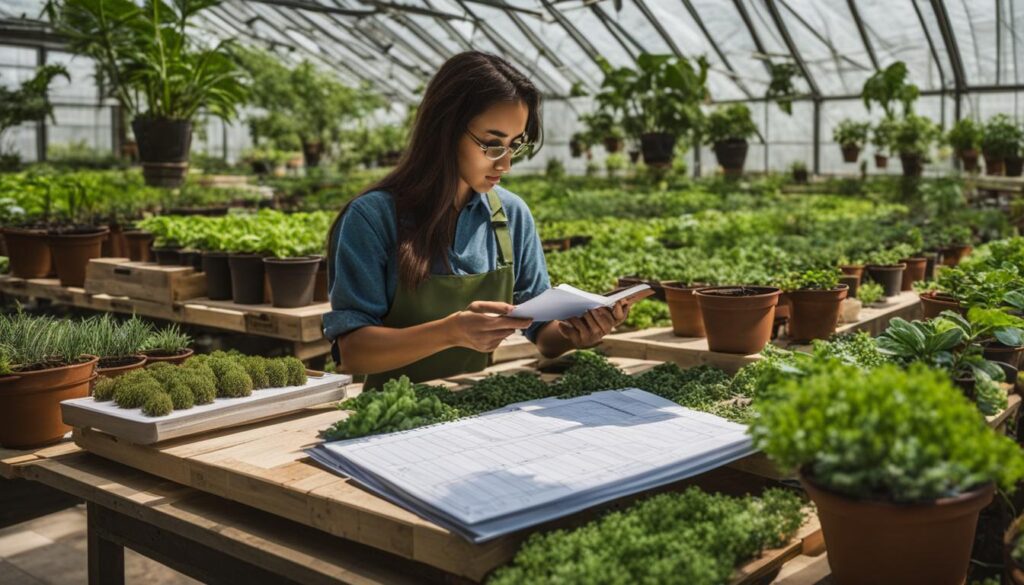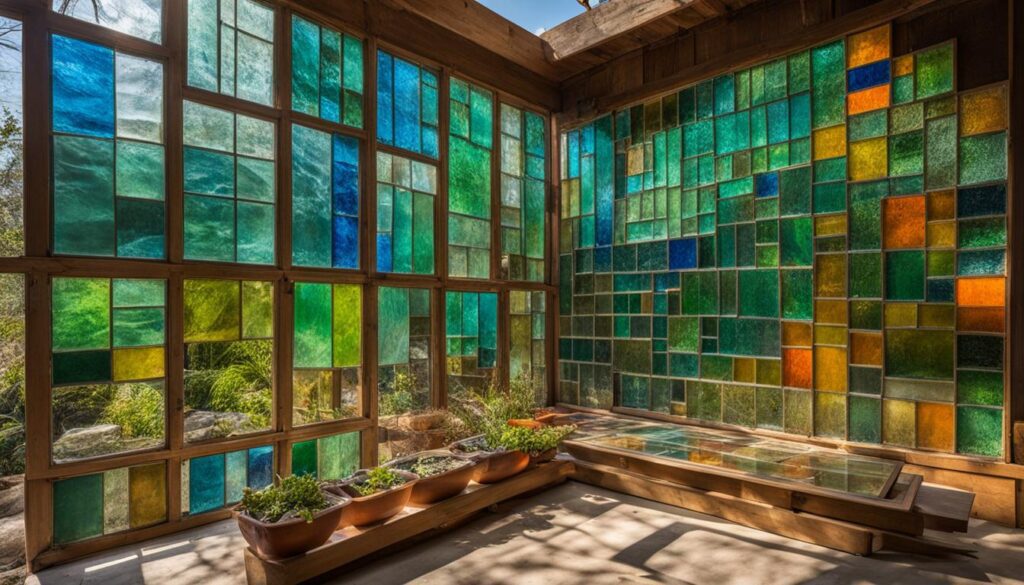Are you considering building a greenhouse but unsure about the costs involved? Greenhouses offer an ideal environment for year-round gardening, allowing you to grow plants and vegetables regardless of the weather conditions outside. However, understanding the cost of building a greenhouse is crucial before embarking on this exciting project.
The cost of a greenhouse can vary depending on several factors. These include the size of the greenhouse, the materials used, and the type of greenhouse you choose to build. On average, building a greenhouse can range from approximately $2,500 to $25,000, with the average cost being around $15,000.
The cost per square foot for a standard mid-sized greenhouse is approximately $25, while large commercial greenhouses can range from $2 to $4 per square foot. The materials used for the frame, siding, and flooring of the greenhouse also contribute to the overall cost. Wood framing costs about $1 per linear foot, while steel framing costs $2.50 per linear foot. Glass siding costs $2.50 per square foot, while alternatives such as polyethylene and fiberglass are more affordable.
The type of greenhouse you choose also affects the cost. Hoop greenhouses typically cost between $5 and $10 per square foot, rooftop greenhouses range from $10 to $25 per square foot, geodesic or dome greenhouses cost between $10 and $25 per square foot, and A-frame greenhouses range from $25 to $35 per square foot.
When considering greenhouse costs, it’s important to factor in not only the initial construction expenses but also ongoing expenses such as maintenance, irrigation systems, and heating systems.
By carefully considering your preferences and requirements, as well as seeking professional advice, you can make informed decisions and invest wisely in your own backyard oasis. Stay tuned for more comprehensive information on factors influencing greenhouse costs, greenhouse covering materials, selecting the right frame material, and other considerations for greenhouse construction costs!
Factors Influencing Greenhouse Costs
When it comes to building a greenhouse, there are several factors that can influence the overall cost. Understanding these factors will help you make informed decisions and plan your budget accordingly.
One of the main factors that impacts the cost of a greenhouse is its size. Larger greenhouses require more materials and labor, which can drive up the overall cost. Consider your gardening needs and space availability when determining the size of your greenhouse.
The materials used for the frame, siding, and flooring of the greenhouse also contribute to the cost. There are various options available, including wood, steel, glass, concrete, and plastic. Each material has its own advantages and cost considerations, so it’s important to choose one that aligns with your budget and preferences.
The type of greenhouse you choose can also affect the cost. Different types, such as hoop, rooftop, geodesic, or A-frame, come with their own construction and material requirements. Understanding the pros and cons of each type will help you make an informed decision based on your specific needs.
Other considerations that can influence greenhouse costs include the need for irrigation systems, heating systems, lighting systems, HVAC and filtration systems, and carbon dioxide fertilization systems. These additional features can enhance the functionality of your greenhouse but also add to the overall cost. It’s essential to carefully assess your requirements and prioritize the features that are most important to you.
Labor costs, energy costs, and the cost of permits and zoning regulations should also be taken into account. Depending on your location and the complexity of the greenhouse construction, these expenses can vary. Researching local regulations and obtaining the necessary permits will help you avoid potential issues and unexpected costs.
Ultimately, the specific requirements and preferences of the individual or business building the greenhouse will determine the overall cost. By considering all of these factors and making informed choices, you can effectively manage the cost of building your greenhouse and create a space that meets your gardening needs.
Comparing Greenhouse Covering Materials
When it comes to greenhouse construction, the choice of covering material plays a crucial role in determining both the cost and functionality of the structure. There are various options available, each with its own advantages and considerations. By understanding the features and costs of different greenhouse covering materials, you can make an informed decision that best suits your needs.
Glass
Glass is a popular choice for greenhouse covering due to its durability and high light transmission. It allows ample sunlight into the greenhouse, promoting healthy plant growth. However, one drawback of glass is that it can magnify sunlight, potentially leading to overheating and plant burn. Glass siding typically costs around $2.50 per square foot.
Polycarbonate
For a more cost-effective and durable option, polycarbonate is worth considering. It offers good light transmission while providing insulation for the greenhouse. Polycarbonate panels are available in different thicknesses, with costs ranging from $0.90 to $2.20 per square foot. This affordability and durability make polycarbonate a popular choice among greenhouse owners.
Polyethylene Film
If budget is a primary concern, polyethylene film is an affordable option for greenhouse covering. It is lightweight and easy to install. However, it is important to note that polyethylene film is less durable compared to other materials and requires regular maintenance. The cost of polyethylene film is as low as $0.12 per square foot.
Acrylic Panels
Acrylic panels offer high light transmission and durability, making them suitable for greenhouse covering. However, they require careful handling to prevent scratching or cracking. Acrylic covering material costs between $1.95 and $3.00 per square foot, depending on the thickness and quality.
When selecting a covering material for your greenhouse, consider factors such as light transmission, insulation, durability, and budget. Assess the specific needs and requirements of your plants to ensure optimal growth and protection within the greenhouse structure.
Selecting the Right Frame Material for Your Greenhouse
The frame material of a greenhouse plays a crucial role in providing structural support and determining its longevity and durability. When choosing the right frame material for your greenhouse, there are several options to consider based on your specific needs and preferences.
Wood
Wood is a popular and affordable choice for greenhouse frame material. It offers a natural and aesthetically pleasing look that blends well with outdoor surroundings. Wood frames typically cost about $1 per linear foot, making them budget-friendly for greenhouse construction. However, it’s essential to note that wood may require regular maintenance and treatment to protect against weather elements and insect damage.
Steel
If you prioritize durability and the ability to withstand harsh weather conditions, steel frames are an excellent option. Steel provides exceptional strength and structural integrity, making it suitable for long-term greenhouse projects. Although steel frames come at a higher cost, around $2.50 per square foot, the investment can pay off in terms of longevity and minimal maintenance requirements.
PVC and Aluminum
Alternative frame materials for greenhouses include PVC and aluminum. PVC frames offer cost-effective solutions and are lightweight, making them easy to work with during construction. They are resistant to corrosion and require minimal maintenance. Aluminum frames, on the other hand, provide durability, stability, and resistance to rust and corrosion. The choice between PVC and aluminum will depend on factors such as budget, aesthetic preferences, and the specific requirements of your greenhouse.
When making a decision about greenhouse frame materials, it’s important to consider factors such as durability, aesthetics, and budget. It’s recommended to consult with professionals or experts in greenhouse construction to get personalized recommendations based on your specific greenhouse project. By selecting the right frame material, you can ensure the structural integrity and longevity of your greenhouse, creating a thriving environment for your plants.
Other Considerations for Greenhouse Construction Costs
In addition to the size, materials, covering material, and frame material, there are other considerations that can impact the cost of greenhouse construction. These include the cost of irrigation systems, heating systems, lighting systems, HVAC and filtration systems, carbon dioxide fertilization systems, and labor costs for installation and maintenance. Energy costs and the cost of permits and zoning regulations should also be taken into account. Proper planning, budgeting, and research are crucial for managing greenhouse construction costs effectively.
When it comes to greenhouse construction, there are various factors to consider that can potentially add to the overall cost. One important consideration is the installation of irrigation systems. Depending on the size of the greenhouse and the type of plants being grown, an irrigation system may be necessary to ensure proper watering and plant health. These systems can include drip irrigation, sprinkler systems, or overhead misting systems. The cost of installing an irrigation system can vary depending on the complexity of the system and the specific needs of the plants.
Heating systems are another consideration that can impact the cost of greenhouse construction. In colder climates or during the winter months, a heating system may be necessary to maintain a suitable temperature for plant growth. Heating systems can range from simple heaters to more complex systems, such as radiant heating or underfloor heating. The cost of installing a heating system will depend on the size of the greenhouse and the specific heating requirements.
Lighting systems are an essential consideration for greenhouse construction, particularly in areas with limited natural sunlight or for growing plants that require specific light conditions. Supplemental lighting systems can include fluorescent lights, LED lights, or high-intensity discharge (HID) lights. The cost of installing a lighting system will vary depending on the size of the greenhouse and the specific lighting requirements.
When it comes to maintaining a suitable climate inside the greenhouse, HVAC and filtration systems may be necessary. These systems help regulate temperature, humidity, and air quality. HVAC systems can include fans, vents, and evaporative coolers, while filtration systems help remove dust, pollen, and other particles from the air. The cost of installing HVAC and filtration systems will depend on the size of the greenhouse and the specific climate control requirements.
Carbon dioxide fertilization systems are another consideration for greenhouse construction. Carbon dioxide is essential for plant growth, and in some cases, it may be necessary to supplement the natural levels of carbon dioxide in the air. Carbon dioxide fertilization systems can include generators or tanks that release controlled amounts of carbon dioxide into the greenhouse. The cost of installing a carbon dioxide fertilization system will depend on the size of the greenhouse and the specific carbon dioxide requirements.
Labor costs for installation and maintenance should also be taken into account when considering greenhouse construction costs. Depending on the size and complexity of the greenhouse project, professional installation may be necessary. Additionally, regular maintenance and upkeep, such as cleaning, repairs, and plant care, will require time and effort. Factoring in labor costs will help ensure an accurate estimate of the overall greenhouse construction costs.
Energy costs, including electricity and fuel, should be considered when budgeting for greenhouse construction. The operation of heating systems, lighting systems, HVAC systems, and other equipment will require energy. It is important to estimate these costs to have a clear understanding of the ongoing expenses associated with greenhouse operations.
Finally, the cost of permits and zoning regulations should not be overlooked. Before constructing a greenhouse, it is important to research and comply with local building codes, permits, and zoning requirements. The cost of obtaining permits and meeting regulatory standards will vary depending on the location and specific regulations.
Proper planning, budgeting, and research are crucial for managing greenhouse construction costs effectively. By considering all the necessary factors and accounting for potential expenses, one can ensure that the final greenhouse construction project stays within budget and meets all requirements.
Are Greenhouses a Cost-Effective Option Compared to Outdoor Fireplaces?
When it comes to the comparison of greenhouses and outdoor fireplaces, the outdoor fireplace costs uncovered may outweigh the cost-effectiveness of greenhouses. While greenhouses have their benefits, the expenses associated with outdoor fireplaces, from installation to maintenance, can sometimes make them a less cost-effective option.
Conclusion
Building a greenhouse can be a significant investment, but it offers the opportunity for year-round gardening and controlled plant growth. The cost of building a greenhouse can vary based on factors such as size, materials, covering material, frame material, and additional features. Thorough research and planning for all aspects of greenhouse construction are essential to ensure the project stays within budget and meets individual preferences and requirements.
By carefully considering the size of the greenhouse, the materials used for the frame, siding, and flooring, and the type of greenhouse chosen, you can make informed decisions that align with your budget. Additionally, selecting the right covering material and frame material can contribute to the longevity and durability of your greenhouse. It is also important to factor in the costs of additional features such as irrigation systems, heating systems, lighting systems, and other necessary equipment.
To make the most of your greenhouse project, seek professional advice and guidance. Experts can help you navigate the various options and determine the best solutions for your specific needs. With proper planning and budgeting, you can create your own backyard oasis and enjoy the rewards of year-round gardening in a controlled environment.











